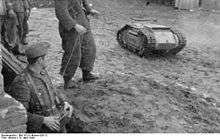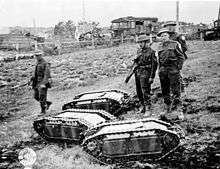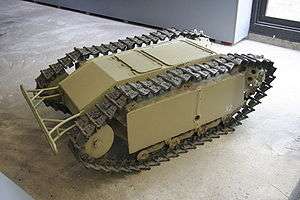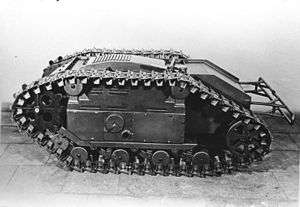Goliath tracked mine
| Goliath Sd.kfz 302 | |
|---|---|
|
An SdKfz. 302, displayed at the Deutsches Panzermuseum, Munster (2005) | |
| Type | Demolition vehicle |
| Place of origin | Germany |
| Service history | |
| In service | 1942-1945 |
| Used by | Nazi Germany, |
| Production history | |
| Designed | 1942 |
| Manufacturer | Borgward and Zundapp. |
| Produced | 1942–1944 |
| Number built | 7564 |
| Specifications | |
| Weight | 370 kg (820 lb) |
| Length | 1.5 m (4.9 ft) |
| Width | 0.85 m (2.8 ft) |
| Height | 0.56 m (1.8 ft) |
| Crew | one remote operator |
|
| |
| Armor | 5mm |
Main armament | 60 kg (130 lb) explosive charge |
| Engine |
Two Electric Motors 2 x 2.5 kw |
Operational range | 1.5 km (0.93 mi) on-road; 0.75 km (0.47 mi) off-road. |
| Goliath Sd.kfz 303 | |
|---|---|
|
An SdKfz. 303, the petrol powered version of the Goliath | |
| Type | Demolition vehicle |
| Place of origin | Germany |
| Service history | |
| In service | 1943-1945 |
| Used by | Nazi Germany, |
| Production history | |
| Designed | 1942 |
| Manufacturer | Zundapp and Zachertz |
| Produced | 1943–1945 |
| Number built | 4929, both the model a and model b |
| Specifications | |
| Weight | 430 kg (950 lb) |
| Length | 1.69 m (5.5 ft) |
| Width | 0.91 m (3.0 ft) |
| Height | 0.62 m (2.0 ft) |
| Crew | none |
|
| |
| Armor | 10mm |
Main armament | 100 kg (220 lb) explosive charge |
| Engine |
Zündapp SZ7 / 2-cylinder 12.5hp |
Operational range | 12 km (7.5 mi) on-road; 7 km (4.3 mi) off-road. |
The Goliath tracked mine - complete German name: Leichter Ladungsträger Goliath (Sd.Kfz. 302/303a/303b) - was a remote controlled German-engineered demolition vehicle, also known as the beetle tank[1] to the Allies.
Employed by the Wehrmacht during World War II. It carried 60 or 100 kilograms (130 or 220 lb) of high explosives, depending on the model, and was intended to be used for multiple purposes, such as destroying tanks, disrupting dense infantry formations, and demolition of buildings and bridges.

Development and use

In late 1940, after recovering the prototype of a miniature tracked vehicle developed by the French vehicle designer Adolphe Kégresse near the Seine, the Wehrmacht's ordnance office directed the Carl F.W. Borgward automotive company of Bremen, Germany to develop a similar vehicle for the purpose of carrying a minimum of 50 kg of explosives. The result was the SdKfz. 302 (Sonderkraftfahrzeug, ‘special-purpose vehicle’), called the Leichter Ladungsträger (‘light charge carrier’), or Goliath, which carried 60 kilograms (130 lb) of explosives. The vehicle was steered remotely via a joystick control box. The control box was attached to the Goliath by a triple-strand cable connected to the rear of the vehicle, for transmitting power to the electric driven version. Two of the strands were used to move and steer the Goliath, while the third was used for detonation. The Goliath had 650 metres (2,130 ft) of cable. Each Goliath was disposable, being intended to be blown up with its target. Early model Goliaths used an electric motor but, as these were costly to make (3000 Reichsmarks) and difficult to repair in a combat environment, later models (known as the SdKfz. 303) used a simpler, more reliable gasoline engine.
Goliaths were used on all fronts where the Wehrmacht fought, beginning in early 1942. They were used principally by specialized Panzer and combat engineer units. Goliaths were used at Anzio in Italy in April 1944, and against the Polish resistance during the Warsaw Uprising 1944. A few Goliaths were also seen on the beaches of Normandy during D-Day, though most were rendered inoperative due to artillery blasts severing their command cables. A small number of Goliaths were also encountered by allied troops in the Maritime Alps following the landings in southern France in August 1944, with at least one being used successfully against a vehicle of the 509th Parachute Infantry Battalion.
Although a total of 7,564 Goliaths were produced, the single-use weapon was not considered a success due to the high unit cost, low speed (just above 6 miles per hour (9.7 km/h)), poor ground clearance (just 11.4 centimeters), vulnerable command cables and thin armour which failed to protect the remote bomb from any form of antitank weapons. The Goliath did help lay the foundation for post-war advances in remote-controlled vehicle technologies.
Romanian version
During 1944, Romania designed and built its own model of remote-controlled tracked mine, known as "Romanian Goliath", due to lack of information about its actual name. However, it was markedly different from its German counterpart. The few surviving photos show that the vehicle had no armor, and it is not known if that was ever changed. It did have some logistical improvements, however, as the Romanian-designed chassis allowed it to cross trenches and craters much better than its German counterparts. Little is known about the stats of this Romanian vehicle, aside from the fact that it never went beyond the prototype stage and that it weighed about two tons.[2]
Surviving examples
Surviving Goliaths are preserved at:
- The Museum of World War II, Massachusetts, USA
- The de:Museum Stammheim, Germany
- the Deutsches Panzermuseum, Germany
- The Tøjhus Museum, Copenhagen, Denmark
- Heeresgeschichtliches Museum, Vienna, Austria
- the Musée du Débarquement Utah Beach, Normandy, France
- Musée des Blindés, Saumur, France
- Musee No. 4 Commando, Ouistreham, Normandy, France
- the Canadian War Museum, Ottawa, Ontario, Canada
- Fort Garry Horse Museum, Winnipeg, Manitoba, Canada
- United States Army Ordnance Museum
- Karl Smith collection, USA
- the Imperial War Museum Duxford, UK
- the Bovington Tank Museum, UK
- The REME Museum, UK
- Dutch Cavalry Museum, Netherlands
- War Museum Overloon, Netherlands
- Het Nederlands kustverdedigingsmuseum: Fort Hoek van Holland Netherlands www.forthvh.nl
- Het memorial museum Nijverdal, Netherlands
- Royal Museum of the Armed Forces and Military History, Belgium
- December 44 Museum, La Gleize, Belgium
- the Kubinka Tank Museum, Russia
- Arsenał in Wrocław, Poland
- Polish Army Museum, Poland
- Warsaw Uprising Museum, Poland
- Muzeum dopravy (transportation museum), Bratislava, Slovakia.
- Swedish Army Museum, Stockholm, Sweden
See also
Notes
Defense against the German Goliath was reenacted in the 1957 Polish film Kanał, documenting the final days of the Warsaw Uprising, the TV series Kolumbowie and the 2014 film Warsaw 44.
References
- Sources
- Chamberlain, Peter, and Hilary Doyle (1999). Encyclopedia of German Tanks of World War Two, 2nd ed. London: Arms & Armour. ISBN 1-85409-214-6.
- Gassend Jean-Loup (2014). Autopsy of a Battle, the Allied Liberation of the French Riviera, August September 1944. Atglen PA: Schiffer Publications.
- Jaugitz, Markus (2001). Funklenkpanzer: A History of German Army Remote-and Radio-Controlled Armor Units, trans. David Johnston. Winnipeg, Manitoba: J.J. Fedorowicz Publishing, Inc. ISBN 0-921991-58-4.
- Jentz, Thomas L. Panzer Tracts, No. 14: Gepanzerte Pionier-Fahrzeuge (Armored Combat Engineer Vehicles, Goliath to Raeumer). S. Darlington, Maryland: Darlington Productions. ISBN 1-892848-00-7
- Morison, Samuel Eliot (1957). History of United States Naval Operations in World War II vol. 11. Boston, Mass.: Atlantic Monthly Press.
External links
| Wikimedia Commons has media related to Borgward "Goliath". |
- Dutch Cavalry Museum has a Goliath-tank in its collection.
- Goliath in Kubinka tank museum
- Relicnews.com has some additional pictures and info that may be of interest. Copyright of the pictures cannot be confirmed so they are linked rather than lifted.
- Leichte Ladungsträger Goliath Sd.Kfz.302 (E-Motor)
- Leichte Ladungsträger Goliath Sd.Kfz.303a / Sd.Kfz.303b (V-Motor)

